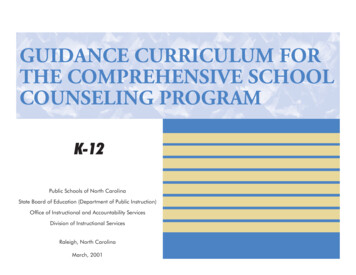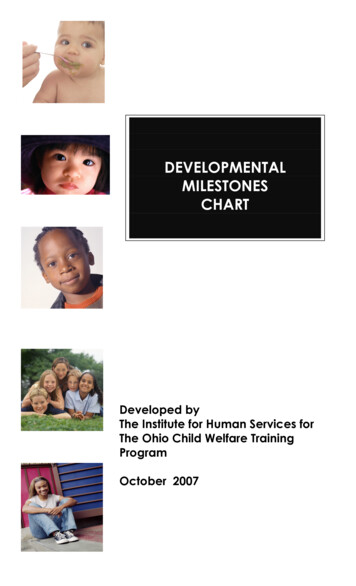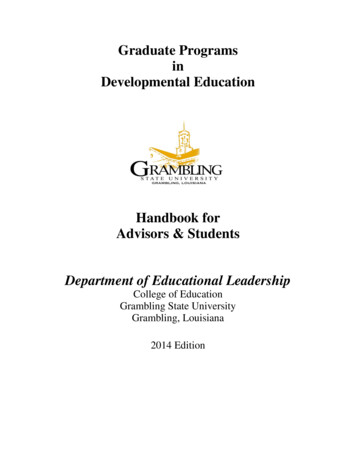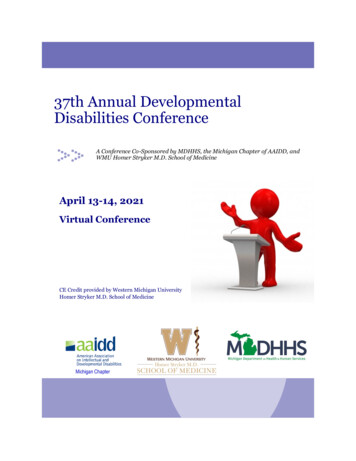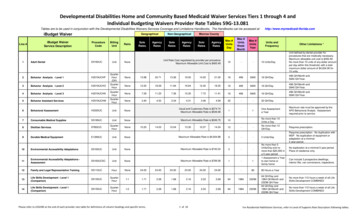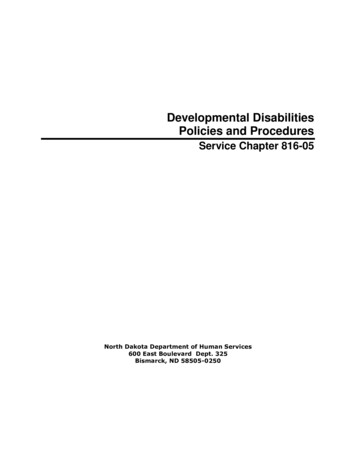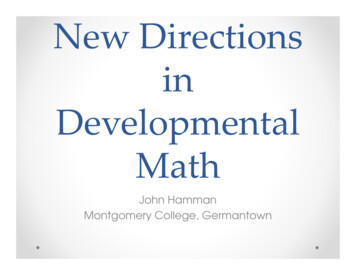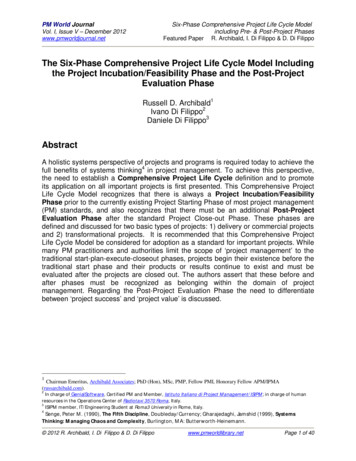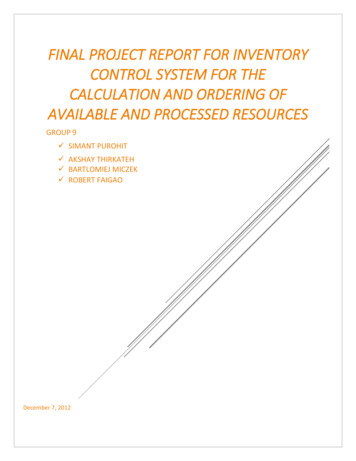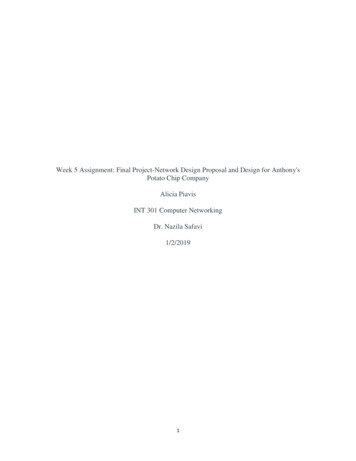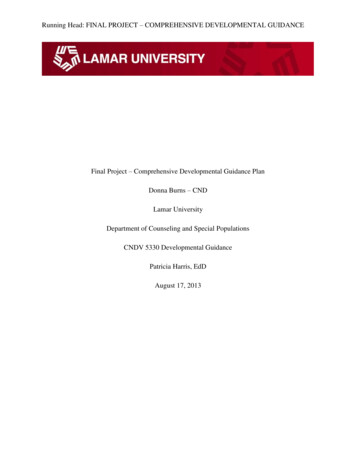
Transcription
Running Head: FINAL PROJECT – COMPREHENSIVE DEVELOPMENTAL GUIDANCEFinal Project – Comprehensive Developmental Guidance PlanDonna Burns – CNDLamar UniversityDepartment of Counseling and Special PopulationsCNDV 5330 Developmental GuidancePatricia Harris, EdDAugust 17, 2013
FINAL PROJECT – COMPREHENSIVE DEVELOPMENTAL GUIDANCE PLANPart IAdvisory CouncilThe importance of building a strong relationship between home and school is an integralpart of a quality education. The purpose of an advisory council is to bring key stakeholders intothe campus environment (figuratively and perhaps literally) to help build the connection betweenhome and school. Specifically, the advisory team serves to assess and review the goals andresults of the comprehensive school counseling program (CSCP), make recommendations, andpromote an understanding of the CSCP with the school and community. Members of theadvisory team could include students, parents/guardians, teachers, counselors, administrators andcommunity members.School Mission StatementA school’s mission statement should define its purpose and direction as well as outline itscore values. On the flip side, a school’s mission statement can help students and parents decide ifthe school’s purpose and programs, and the way it provides these services, line up with personaleducational goals. The mission statement of Manvel High School (the school in which I hope tosecure employment as a professional school counselor) states that MHS will prepare students tobe successful in a dynamic global society through a rigorous curriculum. Using professionalresources and technology, staff will collaborate with parents, students, and the community todevelop life-long learners and innovative critical thinkers who will contribute to society at theirfull potential.Counseling Program Mission StatementThe purpose of the counseling program mission statement is to support the school’smission. It also allows for collaboration with other individuals and organizations to promote allstudents’ academic, career and personal/social development. The mission of the counselingPage 2 of 22
FINAL PROJECT – COMPREHENSIVE DEVELOPMENTAL GUIDANCE PLANprogram at Manvel High School is to provide all students with the academic, personal and socialskills necessary to become responsible, productive and respectful individuals who develop intocontributing members of society by means of comprehensive and developmental support.Personal Counselor Mission StatementA personal counselor mission statement is important because it gives others insight intothe valuable skills and attitudes available to students who may be struggling with personal/social,academic and/or (future) career issues. A well-written statement will provide clarity about therole of the professional school counselor by defining who we are, how work and collaborate withcampus staff, and what we do to help all children on campus to achieve academic success.ASCA StandardsThe American School Counselor Association’s (ASCA) School Counselor Competencies(2012) that align with the above information are as follows:II. Foundations - School counselors should possess the knowledge, abilities, skills and attitudesnecessary to establish the foundations of a school counseling program aligning with the ASCANational Model.II-B: Abilities & Skills - An effective school counselor is able to accomplish measurableobjectives demonstrating the following abilities and skills:Develops the beliefs and vision of the school counseling program that align withII-B-1.current school improvement and student success initiatives at the school, districtand state levelDevelops a school counseling mission statement aligning with the school, districtII-B-2.and state missionUses student standards, such as ASCA Student Standards and other appropriateII-B-3.student standards such as district or state standards, to drive the implementation of acomprehensive school counseling programIII. Management - School counselors should possess the knowledge, abilities, skills and attitudesnecessary to manage a school counseling program aligning with the ASCA National Model.III-B: Abilities & Skills - An effective school counselor is able to accomplish measurableobjectives demonstrating the following abilities and skills:Establishes and convenes an advisory council for the comprehensive schoolIII-B-2.counseling programUses leadership skills to facilitate vision and positive change for the comprehensiveIII-B-2a.school counseling programPage 3 of 22
FINAL PROJECT – COMPREHENSIVE DEVELOPMENTAL GUIDANCE etermines appropriate education stakeholders who should be represented on theadvisory councilDevelops effective and efficient meeting agendasReviews school data, school counseling program assessment and school counselingprogram goals with the advisory councilRecords meeting notes and distributes as appropriateAnalyzes and incorporates feedback from the advisory council related to schoolcounseling program goals as appropriatePage 4 of 22
FINAL PROJECT – COMPREHENSIVE DEVELOPMENTAL GUIDANCE PLANPart IINeeds AssessmentAccording to Dollarhide & Saginak (2012), needs assessments are important because datagleaned from such evaluations are integral in the early planning processes of a school counselingprogram. School counselors use these data to determine their selection of interventions, such assmall groups, presentations/workshops, classroom guidance lessons, schoolwide initiatives andprograms, and professional development initiatives. This information will also allow professionalschool counselors to speak the language of decision makers, thus allowing social and academicadvocacy for children with special needs or those encountering systemic barriers to academic,career, or personal/social success (Erford, 2011). Additionally, “school counselors who closelymonitor, through evaluation, the effects that programs and interventions are having on factorsthat directly associate with learning and attainment are providing invaluable information forsustaining their role within schools” (Dollarhide & Saginak, 2012, p. 114).Manvel High School is one of 22 campuses, and only two high schools, in Alvin ISD.When it opened its doors in 2006, approximately 650 students (grades 9-10 only) attended MHS;as of last year, that number rose to 1,953 students in grades 9 to 12—an increase of just over200%. Since opening, MHS has integrated many research-based and school-wide programs,such as AVID, PBIS, Thinking Maps, Building Academic Vocabulary, as well as a 4-tieredcredit recovery plan designed to increase the campus/district graduation rate. MHS was once atitle I school (2009-10), but no longer holds that status or receives federal funding as such.Finally, a Phase II expansion plan was completed at MHS two years ago; according to currentenrollment numbers, the school will reach full capacity with the 2013-14 school year.Manvel High School serves predominantly low-middle class families. The breakdown ofits student population is as follows: 27% African-American, 29% Anglo, 11% Asian, 33%Page 5 of 22
FINAL PROJECT – COMPREHENSIVE DEVELOPMENTAL GUIDANCE PLANHispanic, 53% male, 47% female and 39% low socioeconomic status. MHS serves 76 EnglishLanguage Learner students, 170 students in the Gifted and Talented program, 41 students qualifyfor 504 services, and 171 students are served through special education services.The overall mobility rate for the campus is approximately 12%, with a drop-out rate of0.7%. The average daily attendance rate for students in 2012-13 was 95.3%. The average dailyattendance rate for staff was 95%. There were a total of 4562 discipline referrals for 2012-13,which is significantly less than the previous year.The staff population is 14% African-American, 76% Anglo, 1% Asian, 9% Hispanic, 1%Native American, 37% male and 64% female with an average of 7 years of experience. Theinstructional staff includes 100% Highly Qualified teachers and 100% Highly Qualifiedparaprofessionals (Alexander, 2011).Assessment InstrumentsAccording to Erford (2011), accountability in the school counseling program mustaddress five primary questions using the five accountability measures noted in parenthesesfollowing each question: (1) Is a comprehensive, standards-based program in place? (program[process] evaluation or audit) (2) What are the needs of the school’s student population whencompared to these standards? (needs assessment) (3) What services were implemented to addressthe identified needs and standards? (service assessment) (4) What was the result of theimplemented services? (results or outcomes studies) (5) How well is the professional schoolcounselor performing? (performance evaluation/appraisal).For the purpose of this assignment, this focus of this section will be on needs assessment.The most common way of initiating a needs assessment is through observations of students andconversations with teachers, parents, administration, and students. More formal needsPage 6 of 22
FINAL PROJECT – COMPREHENSIVE DEVELOPMENTAL GUIDANCE PLANassessments may be conducted through surveys, which can be administered in person, by mail, email, or through the Internet (e.g. Survey Monkey, Zoomerang, Survey Gizmo).Online surveys are a cost effective method of data-driven evaluation that allow schoolcounselors to: collect responses to a large number of questions; easily summarize and report data; evaluate results through statistical measures; ensure anonymity of respondents, if necessary; amass ample information because of high rates of return.Interviews, a perception-driven method of evaluation, are the process of collecting databy conversing with others. An interview can be face-to-face or through some means oftechnology (phone, video conference or online), and will involve an interviewer andinterviewee(s). Some benefits to conducting needs assessments via interview are: its cost efficiency; open-ended questions give way to broad perspective; depth of information greater because interviewer can probe for more details; messages can be communicated more clearly due to the visual of body language.Focus groups are group discussions conducted in person among a limited number ofstakeholders in order to gain information about their views and experiences. Some advantages ofusing focus groups as a needs assessment include: ease of set up and arrangement; efficient and inexpensive means of data collection; creates opportunity to bring personnel and stakeholders together with beneficiaries;Page 7 of 22
FINAL PROJECT – COMPREHENSIVE DEVELOPMENTAL GUIDANCE PLAN shared dialogue can stimulate discussion and generate new ideas.Personal observation is among the least invasive and most easily implemented way toevaluate students and their needs. Informal observations tend to yield anecdotal data through a“look-and-see” approach. Formal or structured observations usually involve a protocol andpredetermined procedures for collecting specific types of data during a specified time period;structured procedures tend to minimize bias (Erford, 2011). Some of the advantages toobservations are: ease of implementation; efficient with regard to time and cost; encourage development of relationship with participating stakeholders.Regardless of which format works best for evaluation, professional school counselorsshould be mindful to follow these steps when formulating a needs assessment:1. Decide what you need to know.2. Decide on the best approach to derive what you need to know.3. Develop the needs assessment instrument or method.4. Enlist the support of colleagues and a few individuals from the target groups to reviewand try out items for understanding.5. Implement the final version with the target groups.6. Tabulate, analyze, and interpret the results.7. Translate the results into programmatic goals and objectives (Erford, 2011).Guidance CurriculumThe school counseling curriculum provides a vehicle for delivering information andconnecting with every student in a systematic way. It assists students in achieving desiredcompetencies. A well-suited curriculum will also provide all students with the knowledge andPage 8 of 22
FINAL PROJECT – COMPREHENSIVE DEVELOPMENTAL GUIDANCE PLANskills appropriate for their developmental level. Finally, a successful school counseling guidancecurriculum will tie into the school’s overall curriculum and remain effective in all classroomsand group activities, ranging from Kindergarten to 12th grade.Responsive ServicesThe responsive services component of a comprehensive developmental guidance plan(CDGP) will provide additional support to those students with problems that interfere with theirpersonal/social, academic, or career development.Responsive services may range from early intervention to crisis response to meet theindividual student’s needs and address students’ direct, immediate concerns: preventiveinterventions help students who are considering unhealthy solutions to their problems; remedialinterventions are for those students who have already made unwise choices.Responsive services are planned and goal-focused, and may include the followinginterventions: individual and small-group counseling, consulting with staff and parents, andreferring students and families to outside programs.Individual PlanningIndividual student planning involves working with students and their families to developand implement the student’s individual learning plan, which is directed toward identifying andachieving future academic and career goals.Individual or small-group appraisal. School counselors work with students, analyzingand evaluating students’ abilities, interests, skills and achievement. Test information and otherdata are often used as the basis for helping students develop immediate and long-range plans.Consistent with district policy, counselors should meet with students yearly to develop and revisestudents’ academic plans.Page 9 of 22
FINAL PROJECT – COMPREHENSIVE DEVELOPMENTAL GUIDANCE PLANIndividual or small-group advisement. School counselors advise students usingpersonal/social, academic, career and labor market information in planning personal, educationaland occupational goals. The involvement of students, parents or guardians and the school inplanning students’ programs that meet their needs is critical.Parent/student meetings. Counselors should meet with students and their parents annually(or consistent with local district policy) in individual and/or small-group planning conference toreview goals resulting from individual appraisal and advisement. Goals should be revised asnecessary to be consistent with current data and student and parent goals.Next step planning and follow-up. Transitions from one educational program to another,from one school to another, or from school to work will be successful as professional schoolcounselors support students in gathering information, overcoming barriers, and establishingnecessary conditions to maximize student achievement (Harrington & Peterson, 2010).Program SupportSupport of a comprehensive school guidance and counseling program consists ofmanagement activities that establish, maintain, and enhance the CDGP. The program supportcomponent is basically concerned with activities that enrich the total educational program –consulting with teachers, encouraging parental involvement in school, providing input tocurriculum development, community relations and professional development. This componentalso enables the school counseling program to be effective through a variety of activitiesincluding professional development, consultation, collaboration, teaming, program managementand operations. Finally, program support emerges through partnering in a number of publicrelations activities in order to help make various constituent groups aware of programs andservices and to build support for and involvement in those programs.ASCA StandardsPage 10 of 22
FINAL PROJECT – COMPREHENSIVE DEVELOPMENTAL GUIDANCE PLANThe American School Counselor Association’s (ASCA) School Counselor Competencies(2012) that align with the above information are as follows:III. Management - School counselors should possess the knowledge, abilities, skills andattitudes necessary to manage a school counseling program aligning with the ASCA NationalModel.III-B: Abilities & Skills - An effective school counselor is able to accomplish measurableobjectives demonstrating the following abilities and skills:AssessmentAccesses or collects relevant data, including process, perception and outcome data,III-B-3.to monitor and improve student behavior and achievementIV. Delivery - School counselors should possess the knowledge, abilities, skills and attitudesnecessary to deliver a school counseling program aligning with the ASCA National Model.IV-B: Abilities & Skills - An effective school counselor is able to accomplish measurableobjectives demonstrating the following abilities and skills:School Counseling Core CurriculumImplements the school counseling core curriculumIV-B-1.Identifies appropriate curriculum aligned to ASCA Student StandardsIV-B-1a.Develops and presents a developmental school counseling core curriculumIV-B-1b.addressing all students’ needs based on student dataDemonstrates classroom management and instructional skillsIV-B-1c.Develops materials and instructional strategies to meet student needs and schoolIV-B-1d.goalsEncourages staff involvement to ensure the effective implementation of the schoolIV-B-1e.counseling core curriculumKnows, understands and uses a variety of technology in the delivery of schoolIV-B-1f.counseling core curriculum activitiesUnderstands multicultural and pluralistic trends when developing and choosingIV-B-1g.school counseling core curriculumUnderstands and is able to build effective, high-quality peer helper programsIV-B-1h.Individual Student PlanningFacilitates individual student planningIV-B-2.Understands individual student planning as a component of a comprehensiveIV-B-2a.programDevelops strategies to implement individual student planning, such as strategies forIV-B-2b.appraisal, advisement, goal-setting, decision-making, social skills, transition orpost-secondary planningHelps students establish goals and develops and uses planning skills inIV-B-2c.collaboration with parents or guardians and school personnelUnderstands career opportunities, labor market trends and global economics andIV-B-2d.uses various career assessment techniques to help students understand their abilitiesand career interestsHelps students learn the importance of college and other post-secondary educationIV-B-2e.and helps students navigate the college admissions processPage 11 of 22
FINAL PROJECT – COMPREHENSIVE DEVELOPMENTAL GUIDANCE PLANUnderstands the relationship of academic performance to the world of work, familylife and community serviceUnderstands methods for helping students monitor and direct their own learningIV-B-2g.and personal/social and career developmentResponsive ServicesProvides responsive servicesIV-B-3.Lists and describes interventions used in responsive services, such asIV-B-3a.individual/small-group counseling and crisis responseUnderstands appropriate individual and small-group counseling theories andIV-B-3b.techniques such as rational emotive behavior therapy, reality therapy, cognitivebehavioral therapy, Adlerian, solution-focused brief counseling, person-centeredcounseling and family systemsDemonstrates an ability to provide counseling for students during times ofIV-B-3c.transition, separation, heightened stress and critical changeUnderstands what defines a crisis, the appropriate response and a variety ofIV-B-3d.intervention strategies to meet the needs of the individual, group or schoolcommunity before, during and after crisis responseIV-B-2f.Page 12 of 22
FINAL PROJECT – COMPREHENSIVE DEVELOPMENTAL GUIDANCE PLANPart
Lamar University Department of Counseling and Special Populations . Patricia Harris, EdD August 17, 2013 . FINAL PROJECT – COMPREHENSIVE DEVELOPMENTAL GUIDANCE PLAN Page 2 of 22 Part I Advisory Council The importance of building a strong relationship between home and school is an integral
